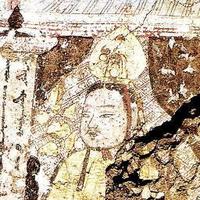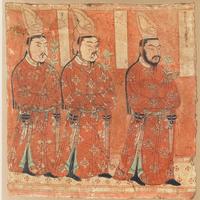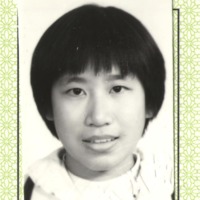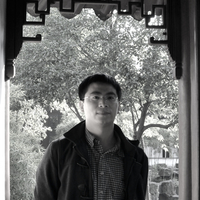
Dai MATSUI
My research interest is the history of Central Asia, mainly East Turkistan (modern Xinjiang) under domination of the Uighur kingdom (9-12. cent) and the Mongol empire (13-14. cent.).
As well I have been engaged in the philological edition of Old Uighur and Mongolian documents excavated from Xinjiang and Dunhuang (Gansu), to provide the source materials as the basis for historical reconstruction.
Address: Graduate School of Humanities, University of Osaka
1-5 Machikaneyama, Toyonaka, Osaka
560-8532 JAPAN
As well I have been engaged in the philological edition of Old Uighur and Mongolian documents excavated from Xinjiang and Dunhuang (Gansu), to provide the source materials as the basis for historical reconstruction.
Address: Graduate School of Humanities, University of Osaka
1-5 Machikaneyama, Toyonaka, Osaka
560-8532 JAPAN
less
Related Authors
Tursunjan IMIN
Lanzhou University
Fang Wang王芳
Leipzig University (Universität Leipzig)
Shang SHI 石尚
Capital Normal University
Yuan Zhang
Chinese Academy of Social Sciences
Zhenru ZHOU
Tsinghua University
王中旭 Wang Zhongxu
The Palace Museum
Lilla Russell-Smith
Staatliche Museen zu Berlin, Stiftung Preußischer Kulturbesitz
Mujun LUO
Zhejiang University of Technology
InterestsView All (81)







Uploads
Books by Dai MATSUI
The 107 Old Uigur documents are classified into nine groups and edited with fully annotated English translations.
The facsimiles of 71 documents are provided in 58 figures on 36 plates. They have been thus far unpublished or not readily available on the Internet databases, as well as significant from the viewpoint of historical analysis.
Purchasable at https://www.brepols.net/products/IS-9782503604893-1
Papers by Dai MATSUI
The gist is also included in Matsui 2023, Old Uigur Administrative Orders (BTT 48), 54–56.
Turkic graffiti inscriptions from Central Asia. Most of these, written on the walls of Buddhist sanctuary cave temples (in Turfan, Xinjiang, and Dunhuang, Gansu), consist of the memorial writings of pilgrims and visitors. These graffiti inscriptions demonstrate the diversity of Old Uyghur literary culture and Buddhist cults, as well as various aspects of their daily lives that are undetectable from the enormous Buddhist religious canons; examples of religious practices conducted by visitors and pilgrims at cave temples; and the nodes and terminals of their geographical network.
The Japanese enlarged version of "Musing on "Qubilai’s Testament,” in Türkçe ve Moğolca Çalışmaları Sempozyumu: Sir G. Clauson ve Talat Tekin’in katkıları, İstanbul, 2022.12, 55–67
松井太「トルキスタン・トルコ系諸集團とモンゴル帝國」弘末雅士・荒川正晴(編)『モンゴル帝國と海域世界:12~14世紀』(岩波講座世界歷史10)岩波書店,2023.4, 133–158.
Matsui Dai, Turkistan, Turkic Nations and Mongol Empire. In: Hirosue Masashi and Arakawa Masaharu (eds.), Mongol Empire and the Maritime Regions of the 12th–14th Centuries, Tokyo: Iwanami Shoten, 2023.4, 133–158.
Turkish versions has been already published: "Eski Uygur Hukuk Belgelerinde Geçen borun ve borunluq Üzerine" in Eski Türkçeden Çağdaş Uygurcaya (Konya, 2015); and Japanese version "Joint Surety Association in the Old Uigur Society in Turfan" in The Worlds of Dunhuang-Turfan Documents and Their Ages (Tokyo, 2017).
IOM RAS preserves 55 Old Uighur manuscripts related to a group of Buddhist Uighurs who were active around the monastery of abita qur “Abita Cave” at the Toyoq Cave Temples. This paper investigates the location of the “Abita Cave” through Uighur wall inscriptions, which have been discovered at the monastery complex in the West Zone of the Toyoq site. Furthermore, this paper inquires into an Old Uighur toponym mentioned as the hometown of the scribe of one of the 55 manuscripts, which would suggest the pilgrimage range surrounding the Toyoq Caves.
There are images depicting the motif of the Eighty-four Mahasiddhas drawn in cave 9 at the Great Peach Valley Grottoes [Da Tao-er gou 大桃兒溝 = Qurtqa caves]. The names of many of the siddhas have been verified by analyzing the images and consulting Uighur manuscripts, while the identities of others require further investigation.
By comparing these images with descriptions found in the Uighur texts unearthed from the northern area of the Mogao Grottoes, researchers were able to reconstruct the original order and positioning of the siddhas in this cave. On the basis of the above analyses, two conclusions have been reached that shed light on the history of artistic production and the structure of the regional belief system. Firstly, the images of the Eighty-Four Mahasiddhas in cave 9 are based on the text of Biography of Eighty-Four Great Mahasiddhas, which was unearthed from the northern area of the Mogao Grottoes. Secondly, the consistency between the image of the great siddhas in cave 9 and the description of the same motif in the Biography of Eighty-Four Great Mahasiddhas indicates that belief in the Eighty-four Mahasiddhas was the same in both Turpan and Dunhuang.
Several inscriptions have been further modified in Matsui, Remarks on Buyan-Qaya, a Uighur Buddhist Pilgrim to Dunhuang, in Z. Özertural/G. Şilfeler (eds.), Unter dem Bodhi-Baum: Festschrift für Klaus Röhrborn anlässlich des 80. Geburtstags, 2019.
This paper offers an edition of a Syro-Uigur wall inscription of Yulin Cave 16.
It is the first example of Christian Turkic text discovered at Dunhuang region.
The inscription was written in the Yuan period by Uigur-Christian pilgrims coming from ⽠州 Guazhou, and clearly displays the presence of Christian Uigurs around Dunhuang under the Yuan dynasty.
Also this paper proves that the Christian Uigurs shared some part of cultural tradition with Buddhists.
The 107 Old Uigur documents are classified into nine groups and edited with fully annotated English translations.
The facsimiles of 71 documents are provided in 58 figures on 36 plates. They have been thus far unpublished or not readily available on the Internet databases, as well as significant from the viewpoint of historical analysis.
Purchasable at https://www.brepols.net/products/IS-9782503604893-1
The gist is also included in Matsui 2023, Old Uigur Administrative Orders (BTT 48), 54–56.
Turkic graffiti inscriptions from Central Asia. Most of these, written on the walls of Buddhist sanctuary cave temples (in Turfan, Xinjiang, and Dunhuang, Gansu), consist of the memorial writings of pilgrims and visitors. These graffiti inscriptions demonstrate the diversity of Old Uyghur literary culture and Buddhist cults, as well as various aspects of their daily lives that are undetectable from the enormous Buddhist religious canons; examples of religious practices conducted by visitors and pilgrims at cave temples; and the nodes and terminals of their geographical network.
The Japanese enlarged version of "Musing on "Qubilai’s Testament,” in Türkçe ve Moğolca Çalışmaları Sempozyumu: Sir G. Clauson ve Talat Tekin’in katkıları, İstanbul, 2022.12, 55–67
松井太「トルキスタン・トルコ系諸集團とモンゴル帝國」弘末雅士・荒川正晴(編)『モンゴル帝國と海域世界:12~14世紀』(岩波講座世界歷史10)岩波書店,2023.4, 133–158.
Matsui Dai, Turkistan, Turkic Nations and Mongol Empire. In: Hirosue Masashi and Arakawa Masaharu (eds.), Mongol Empire and the Maritime Regions of the 12th–14th Centuries, Tokyo: Iwanami Shoten, 2023.4, 133–158.
Turkish versions has been already published: "Eski Uygur Hukuk Belgelerinde Geçen borun ve borunluq Üzerine" in Eski Türkçeden Çağdaş Uygurcaya (Konya, 2015); and Japanese version "Joint Surety Association in the Old Uigur Society in Turfan" in The Worlds of Dunhuang-Turfan Documents and Their Ages (Tokyo, 2017).
IOM RAS preserves 55 Old Uighur manuscripts related to a group of Buddhist Uighurs who were active around the monastery of abita qur “Abita Cave” at the Toyoq Cave Temples. This paper investigates the location of the “Abita Cave” through Uighur wall inscriptions, which have been discovered at the monastery complex in the West Zone of the Toyoq site. Furthermore, this paper inquires into an Old Uighur toponym mentioned as the hometown of the scribe of one of the 55 manuscripts, which would suggest the pilgrimage range surrounding the Toyoq Caves.
There are images depicting the motif of the Eighty-four Mahasiddhas drawn in cave 9 at the Great Peach Valley Grottoes [Da Tao-er gou 大桃兒溝 = Qurtqa caves]. The names of many of the siddhas have been verified by analyzing the images and consulting Uighur manuscripts, while the identities of others require further investigation.
By comparing these images with descriptions found in the Uighur texts unearthed from the northern area of the Mogao Grottoes, researchers were able to reconstruct the original order and positioning of the siddhas in this cave. On the basis of the above analyses, two conclusions have been reached that shed light on the history of artistic production and the structure of the regional belief system. Firstly, the images of the Eighty-Four Mahasiddhas in cave 9 are based on the text of Biography of Eighty-Four Great Mahasiddhas, which was unearthed from the northern area of the Mogao Grottoes. Secondly, the consistency between the image of the great siddhas in cave 9 and the description of the same motif in the Biography of Eighty-Four Great Mahasiddhas indicates that belief in the Eighty-four Mahasiddhas was the same in both Turpan and Dunhuang.
Several inscriptions have been further modified in Matsui, Remarks on Buyan-Qaya, a Uighur Buddhist Pilgrim to Dunhuang, in Z. Özertural/G. Şilfeler (eds.), Unter dem Bodhi-Baum: Festschrift für Klaus Röhrborn anlässlich des 80. Geburtstags, 2019.
This paper offers an edition of a Syro-Uigur wall inscription of Yulin Cave 16.
It is the first example of Christian Turkic text discovered at Dunhuang region.
The inscription was written in the Yuan period by Uigur-Christian pilgrims coming from ⽠州 Guazhou, and clearly displays the presence of Christian Uigurs around Dunhuang under the Yuan dynasty.
Also this paper proves that the Christian Uigurs shared some part of cultural tradition with Buddhists.
Available online: http://hdl.handle.net/11094/78221
Available online: http://hdl.handle.net/11094/73677